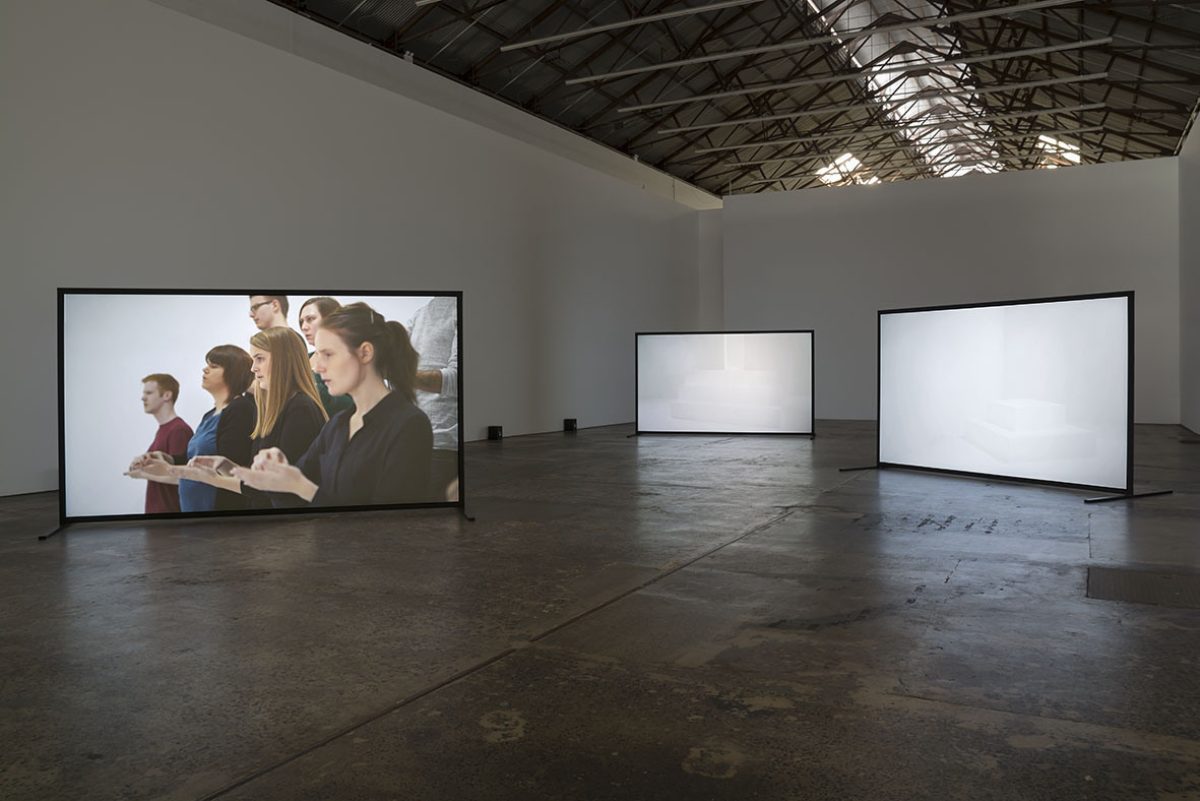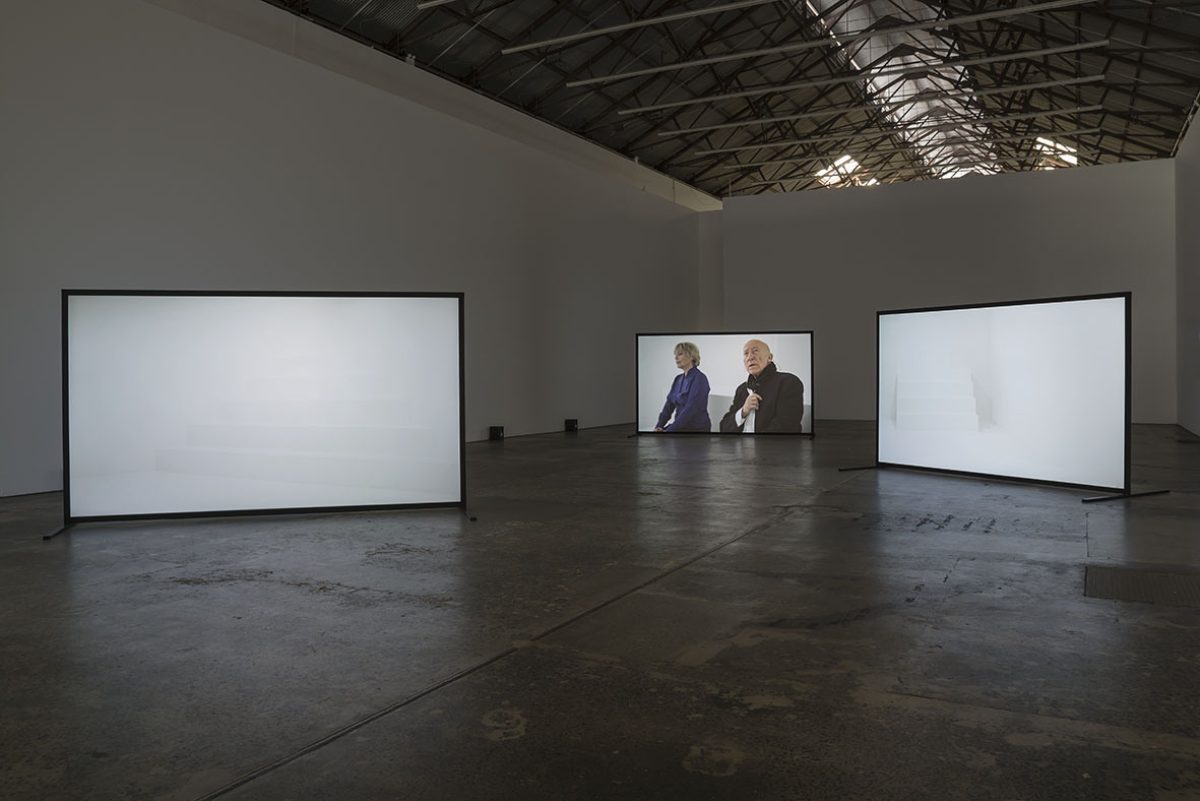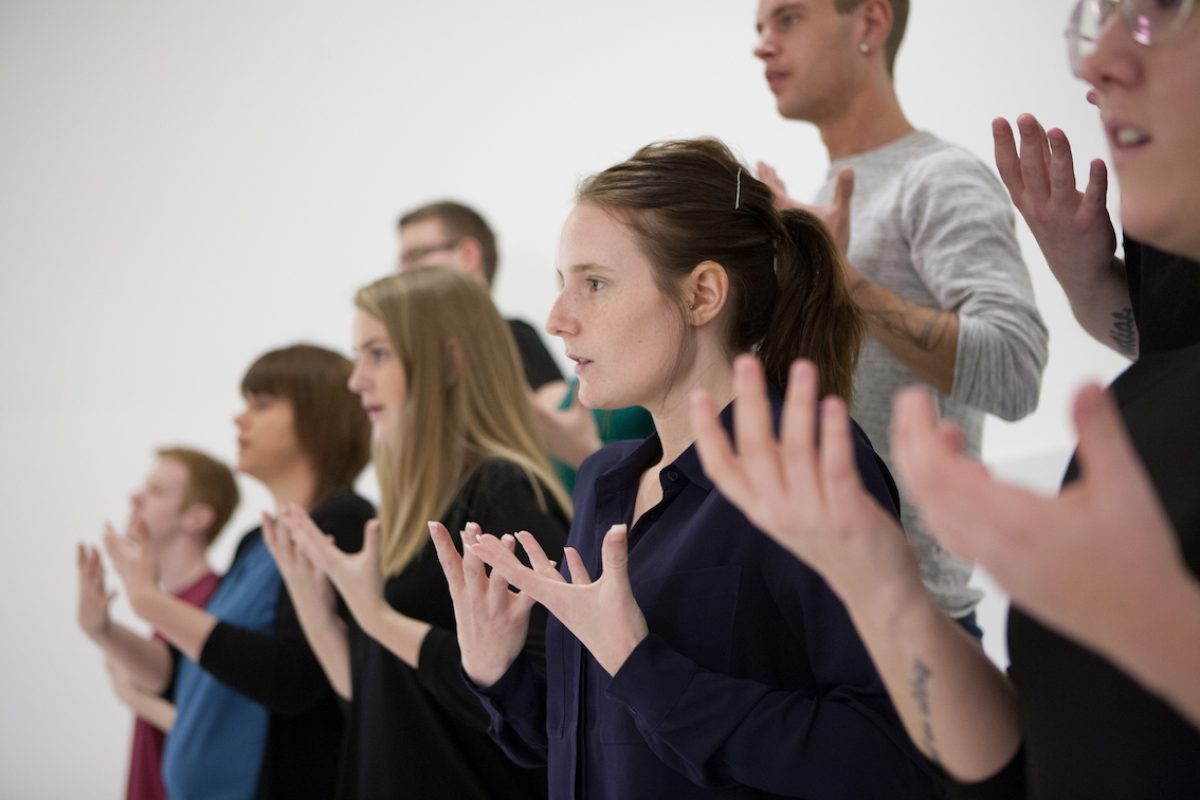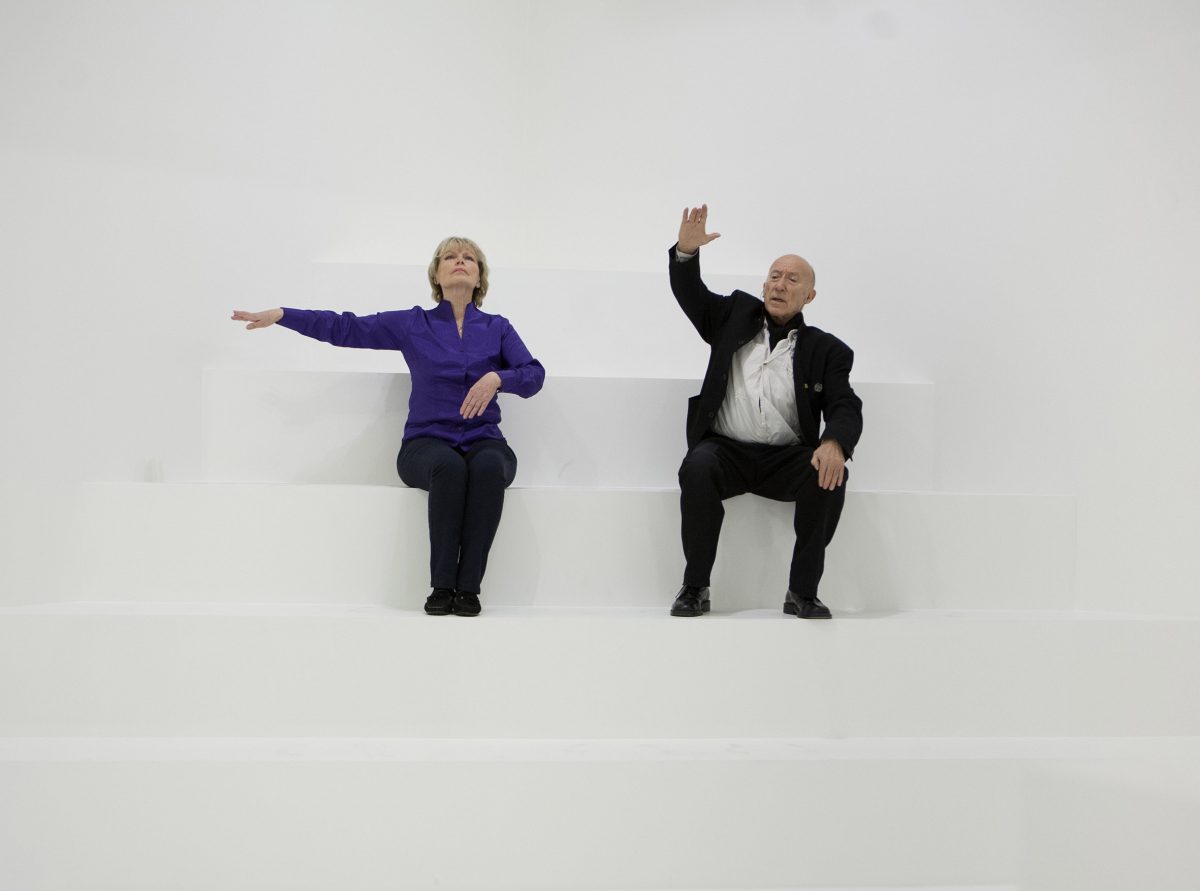Angelica Mesiti
The Colour of Saying
18th April – 13th June 2015
Anna Schwartz Gallery Carriageworks
‘The Colour of Saying’ continues Angelica Mesiti’s interest in the possibilities of non-verbal communication, adapted methods of expression and in looking at a wider spectrum of human interactions.
In this work, Mesiti has collaborated with a choir, two dancers, and two percussionists to explore the use of manual communication and body language to convey meaning. ‘Gestural languages’ become the central focus of this work over three screens that suggests new ways to think about movement, music and silence.
The artist built a set of a monumental staircase-like sculpture which acts as both stage and seating for the performers. The simple but intricate tales told by the performers’ gestures emerge into clear focus via this architectural geometry. The performances take place across the screens, the relationships between them unfolding. We see dance in the illustrated phrases of sign language, and storytelling in the balletic gestures of choreography.
From the quietness, there is an incremental introduction of sound and music as the work evolves. From an almost silent performance by the choir (we hear only the sound of the fabric of clothes and skin brushing skin), we move to the percussionists where the simplest form of music making is introduced; from here to the ballet dancers whom we see at first dancing silently to music on headphones, before we are allowed into their complete immersion in a complex musical opus.
As the films are presented on double-sided projection screens in the gallery, multiple perspectives are visible and the presence of the viewer becomes integral.
The silent choir
In complete silence, a sign language choir performs the choral piece Serenade to Music, composed in 1938 by Vaughan Williams for 16 voices and orchestra. The lyrics are from Act V, Scene I of Shakespeare’s The Merchant of Venice. Lorenzo and Nerissa sit listening to music in the moonlight contemplating the music made by the movement of the planets, which mortal humans cannot hear.
In ‘The Colour of Saying’, the signing choir performs Serenade to Music in silence, ‘singing’ in sign language instead of with their voices. The choral work is performed using only hand gestures and body movements to express the lyrics and tone of the music.
The lyrics are a poetic meditation on the impossibility of ‘hearing’ the metaphysical ‘music of the spheres’ while we are confined to our imperfect physical body. This struggle between what can and cannot be ‘heard’, described in the lyrics of Serenade to Music made it the perfect piece to be translated into sign language, the communication method developed for the hearing-impaired. It is both a celebration of music and a proposition for listening with other senses.
The choir consists of young people from Önnestad folk high school — who are studying to become sign language interpreters. They are conducted by their teacher, Ingegerd Nyborg who translated the lyrics from Swedish to Sign.
Clapping Music
Emerging into the white environment, two young percussionists rupture the silence, by the simplest method: two hands clapping in syncopation. They perform a musical score of rhythmic beats without the use of instrumentation. A minimalist and basic form of music (inspired by Steve Reich’s Clapping Music, 1972), is created with the most modest of means; the body itself offers up the instrument.
For the hearing-impaired, percussion is the musical sound that can be most easily perceived. Vibrations from beats reach the body as sound waves, and visceral sensation is internally translated as musical rhythm.
Swan Song
Rolf Hepp and Jette Nejman are veterans of the ballet profession. Seated on stairs, the ballet dancers ‘dance’ a pas de deux from the ballet Swan Lake using only their hands to express the steps of the choreography. They dance in silence, listening to Tchaikovsky’s score through headphones.
The method they use to perform the ballet is well known to classically trained dancers as ‘hand marking’. It is used in classical ballet rehearsals as a way to ‘mark’ the steps while memorizing the choreography and conserving energy by not physically performing the whole step. For example a pirouette would be expressed by a fist making a turning motion in the air. Employing this method to express the choreography of the “pas de deux” allows the dancers to perform the essential choreography of Swan Lake in a manner permitted by their mature bodies. The dance, performed in relative silence, becomes an act of remembrance of the body’s physical history and also a re-imagining of the original choreography.
Swan Lake, choreographed by Marius Petipa and Lev Ivanov, with the score (Opus 20) composed by Pyotr Ilyich Tchaikovsky in 1876, is the quintessential classical ballet. Its iconic status occupies an important place in the popular imagination and defines what we consider classical ballet to be: romantic, tragic, disciplined, graceful. This re-imagining, developed in collaboration with the dancers, almost strips away the original ballet and leaves us with the human body, no longer in its prime, but imprinted with the experiences of a lifetime.
“I was thinking about Merce Cunningham as an old man, Yvonne Rainer’s ‘pedestrian movements’ and of course Pina Bausch.”
Dancers: Rolf Hepp, Jette Nejman
Percussionists: Viktor Feuk, Tomas Erlandsson
The Sign language choir from Önnestad folk high school, conducted by Ingegerd Nyborg
Cinematographer: Edvard Friis-Moeller
Camera assistant/stills photography: Lars Beyer
Sound recordist: Jakob Riis
Editor: Angelica Mesiti
Sound Designer & Mix: Liam Egan
Colourist: Billy Wychgel
Music: Swan Lake (Opus 20) composed by Pyotr Ilyich Tchaikovsky, 1876.
Performed by Kirov Theatre Orchestra
Conducted by Vikto Fedotov
Recorded at the Mariinsky Theatre in 1990
Presented by NVC Arts 2006
The performance originated in collaboration with, and was produced by Lilith Performance Studio, Malmö, Sweden where it was first performed as a live work in March 2015.
This production was kindly supported by Felix Media.
Images

Angelica Mesiti
The Colour of Saying, 2015
three-channel HD video, colour, sound
25 minutes
installation view, Anna Schwartz Gallery, Carriageworks

Angelica Mesiti
The Colour of Saying, 2015
three-channel HD video, colour, sound
25 minutes
installation view, Anna Schwartz Gallery, Carriageworks

Angelica Mesiti
The Colour of Saying, 2015
three-channel HD video, colour, sound
25 minutes
installation view, Anna Schwartz Gallery, Carriageworks

Angelica Mesiti
The Colour of Saying, 2015
(still) three-channel HD video, colour, sound
25 minutes

Angelica Mesiti
The Colour of Saying, 2015
(still) three-channel HD video, colour, sound
25 minutes




